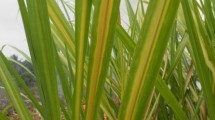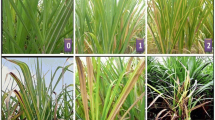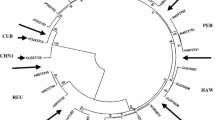Abstract
A survey of Sugarcane yellow leaf virus (SCYLV) was conducted in northern Argentina in 2015 and 2016 using tissue blot immunoassay (TBIA). Results showed plant infection rates of 2.2–86.7% in sugarcane commercial fields from different growing areas. Percentage of infected leaves varied among cultivars and areas. NA 05–860 was the most infected cultivar (86.7% incidence). Virus genotypic diversity of SCYLV positive samples was analysed by reverse transcription polymerase chain reaction (RT-PCR). The virus genotype BRA-PER was found in all samples, followed by genotypes REU and CUB (36% and 8% of positive samples, respectively). The following co-infection patterns were found: BRA-PER + REU (34%); BRA-PER + CUB (6%); and the three genotypes, BRA-PER + REU + CUB (2%). Sugar content loss in cultivar LCP 85–384 infected with SCYLV was evaluated. Sugar yield reduction in SCYLV positive plants was statistically significant in dryland conditions (p < 0.0001). Our results indicate the high prevalence of SCYLV, the first detection of genotypes CUB and REU, and reduction in sucrose content related to SCYLV in Argentina. Disease management in the crop region should include the use of healthy planting material and SCYLV-tolerant cultivars.


Similar content being viewed by others
References
Abu Ahmad Y, Royer M, Daugrois J-H, Costet L, Lett J-M, Victoria J, Girard J-C, Rott P (2006) Geographical distribution of four Sugarcane yellow leaf virus genotypes. Plant Disease 90:1156–1160
Abu Ahmad Y, Costet L, Daugrois J-H, Nibouche S, Letourmy P, Girard J-C, Rott P (2007a) Variation in infection capacity and in virulence exists between genotypes of sugarcane yellow leaf virus. Plant Disease 91:253–259
Abu Ahmad Y, Girard J-C, Fernandez E, Pauquet J, Lockhart B, Letourmy P, Rott P (2007b) Variation in virus populations and growth characteristics of two sugarcane cultivars naturally infected by sugarcane yellow leaf virus in different geographical locations. Plant Pathology 56:743–754
Anino P, Pizzo F (2016) Azúcar. In: informes de cadenas de valor año 1 - N° 3. Ministerio de Hacienda y Finanzas Públicas. [http://www.economia.gob.ar/peconomica/docs/Complejo_Azucar.pdf]. Accessed on May 15, 2019
Asinari F, Rago AM, Cafrune EE (2015) Situación actual del Sugarcane yellow leaf virus en caña de azúcar en argentina. Revista Ciencia y Tecnología de los Cultivos Industriales, Caña de Azúcar 5(7):20–27
Bertani R, Perera M, Arias M, Luque C, Funes C, Gonzalez V, Cuenya M, Ploper L, Welin B, Castagnaro A (2014) A study of the sugarcane yellow leaf disease in Argentina. Plant Disease 98(8):1036–1042
Chinnaraja C, Viswanathan R, Karuppaiah R, Bagyalakshmi K, Malathi P, Parameswari B (2013) Complete genome characterization of Sugarcane yellow leaf virus from India: evidence for RNA recombination. European Journal of Plant Pathology 135:335–349
Cronjé C, Tymon A, Jones P, Bailey R (1998) Association of a phytoplasma with a yellow leaf syndrome of sugarcane in Africa. Annals of Applied Biology 133:177–186
Di Rienzo J, Casanoves F, Balzarini M, Gonzalez L, Tablada M, Robledo 326 C. InfoStat (versión 2017) Grupo InfoStat, FCA, Universidad 327 Nacional de Córdoba, Argentina. URL http://www.infostat.com.ar
Doyle J, Doyle J (1987) A rapid DNA isolation procedure for small quantities of fresh leaf tissue. Phytochemical Bulletin 19:11–15
ElSayed A, Weig A, Komor E (2011) Molecular characterization of Hawaiian sugarcane yellow virus leaf genotypes and their phylogenetic relationship to strains from other sugarcane-growing countries. European Journal of Plant Pathology 129:399–412
Gao S-J, Lin Y-H, Pan Y-B, Damaj M, Wang Q-N, Mirkov T, Chen R (2012) Molecular characterization and phylogenetic analysis of Sugarcane yellow leaf virus isolates from China. Virus Genes 45:340–349
Gonçalves M, Rossini Pinto L, Creste Souza S, Landell M (2012) Virus diseases of sugarcane. A constant challenge to sugarcane breeding in Brazil. In: Ramesh Sundar a, Viswanathan R (eds). Global Science books, Functional Plant Science and Biotechnology, pp 108–116
Grisham M, Pan Y-B, Legendre B, Godshall M, Eggleston G (2001) Effect of Sugarcane yellow leaf virus on sugarcane yield and juice quality. Proceedings International Society of Sugar Cane Technologists 24:434–438
Grisham M, Pan Y, White W, Godshall M, Legendre B, Comstock J (2002) Potential effect of yellow leaf syndrome on the Louisiana sugarcane industry. Journal American Society of Sugar Cane Technologists 22:125–126
Izaguirre-Mayoral M, Carballo O, Alceste C, Romano M, Nass H (2002) Physiological performance of asymptomatic and yellow leaf syndrome-affected sugarcanes in Venezuela. Journal of Phytopathology 150(1):13–19
King AMQ, Adams MJ, Carstens EB, Lefkowitz EJ (2012) Virus taxonomy: ninth report of the international committee on taxonomy of viruses. Academic Press
Lehrer A, Komor E (2008) Symptom expression of yellow leaf disease in sugarcane cultivars with different degrees of infection by Sugarcane yellow leaf virus. Plant Pathology 57:178–189
Lehrer A, Meinzer R, Moore P, Komor E (2001) Physiological consequences of sugarcane yellow leaf virus infection on the sugarcane plant. Proceedings International Society of Sugar Cane Technologists 24:657–659
Lin Y-H, Gao S-J, Damaj M, Fu H-Y, Chen R-K, Mirkov T (2014) Genome characterization of Sugarcane yellow leaf virus from China reveals a novel recombinant genotype. Archives of Virology 159:1421–1429
Lockhart B, Cronjé C (2000) Yellow leaf syndrome. In: Bailey RA, Comstock JC, Croft BJ, Saumtally AS (eds) Rott P. A guide to sugarcane diseases, Cirad ISSCT, pp 291–295
Moonan F, Mirkov T (2002) Analyses of genotypic diversity among north, south, and central American isolates of Sugarcane yellow leaf virus: evidence for Colombian origins and for intraspecific spatial phylogenetic variation. Journal of Virology 76(3):1339–1348
Ramallo J, Ploper L (1998) ¿Síntomas de amarillamiento en cañaverales de Tucumán? Avance Agroindustrial 72:16–18
Rassaby L, Girard J-C, Letourmy P, Chaume J, Irey M, Lockhart B, Kodja H, Rott P (2003) Impact of Sugarcane yellow leaf virus on sugarcane yield and juice quality in Réunion Island. European Jorunal of Plant Pathology 109:459–466
Schenck S, Lehrer A (2000) Factors affecting the transmission and spread of Sugarcane yellow leaf virus. Plant Disease 84:1998–2001
Schenck S, Hu J, Lockhart B (1997) Use of a tissue blot immunoassay to determine the distribution of Sugarcane yellow leaf virus in Hawaii. Sugar Cane 4:5–8
Vega J (1997) Sugarcane yellow leaf disease in Brazil: evidence of association with a Luteovirus. Plant Disease 81:21–26
Wang M, Zhou G (2010) A near complete genome sequence of a distinct isolate of Sugarcane yellow leaf virus from China, representing a sixth new genotype. Virus Genes 41:268–272
Wang M, Xu D, Li R, Zhou G (2012) Genotype identification and genetic diversity of Sugarcane yellow leaf virus in China. Plant Pathology 61:986–993
Zhu Y, Lim S, Schenck S, Arcinas A, Komor E (2010) RT-PCR and quantitative real-time RT-PCR detection of Sugarcane yellow leaf virus (SCYLV) in symptomatic and asymptomatic plants of Hawaiian sugarcane cultivars and the correlation of SCYLV titre to yield. European Journal of Plant Pathology 127:263–273
Acknowledgements
We acknowledge B.E.L. Lockhart (University of Minnesota, St. Paul.) and B.L. Legendre (United States Department of Agriculture), for kindly providing the SCYLV coat protein antibody. We also thank Estación Experimental Agropecuaria (Instituto Nacional Tecnología Agropecuaria) Famaillá, Ledesma S.A.A.I and Ingenio El Tabacal for help in sample collection and technical support.
Author information
Authors and Affiliations
Corresponding author
Additional information
Publisher’s note
Springer Nature remains neutral with regard to jurisdictional claims in published maps and institutional affiliations.
Rights and permissions
About this article
Cite this article
Asinari, F., Pérez Gómez, S.G., Easdale, C. et al. Impact of yellow leaf virus on sugarcane commercial fields. Trop. plant pathol. 46, 37–43 (2021). https://doi.org/10.1007/s40858-019-00322-y
Received:
Accepted:
Published:
Issue Date:
DOI: https://doi.org/10.1007/s40858-019-00322-y




